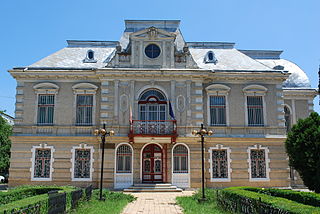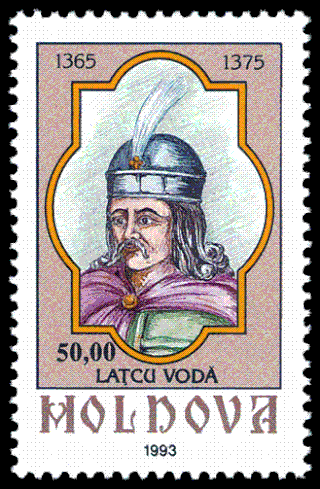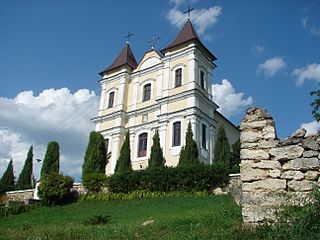Antecedents
Since the 13th century, missionaries of the mendicant orders, Franciscans and Dominicans, created several Latin Catholic communities in present Romania, for whom the Holy See decided to created bishoprics, south and east of the Carpathians (in Walachia and Moldavia), generally short-lived, like the Diocese of Siret / Seret / Cereten(sis) (Latin adjective), established in 1371.
Catholicism was on the rise among the traditionally Orthodox population due to the political late 14th century context, as the Ottoman advance, nearly encircling the imperial capital Constantinople (conquering (H)Adrianopolis, now Edirne, in 1360), the Byzantine emperors sought a political and hopefully military ally in the Catholic west, which had crusaded against Islam to and in the Middle East before.
Similarly in Moldavia, where Bogdan I obtained virtual independence in 1359 as founding voivode (autonomous prince), seeking aid and protection from Poland, welcomed Latin missionaries, Franciscan Friars Minor (founding a monastery at Siret in 1340) and Dominicans.
History
Bogdan's son and indirect successor Lațcu of Moldavia (1365-1373) invited a delegation from Rome, promising his and the people's conversion to Catholicism and asked Pope Urban V to send missionaries and erect a Latin diocese in his principality's capital, Siret. On 24 July 1370 the Pope instructed the archbishop of Prague and bishops of Bratislava and Kraków to verify/complete the sincerity of Laţcu (although his wife remained Orthodox) and mandated them to erect such diocese covering the Moldavian state. Pope Gregory XI established it in 1371, exempt (i.e. directly subject to the Holy See); Polish Franciscan Andrzej Jastrzębiec was consecrated first Bishop by archbishop Florian Mokrski of Kraków. The cathedral, dedicated to John the Baptist, was built by queen Margareth, Catholic kin of the Hungarian royal family, which in 1377 had invited Dominicans to Siret.
However prince Laţcu favoring of Catholicism met grave opposition from the Orthodox clergy, while effective Latin converts were concentrated in the north of Moldavia, near Catholic neighbour kingdoms of Poland and Hungary. Since 1372, when Andrzej was nominated Apostolic administrator of the Archdiocese of Halyč, probably never returning to Siret, he and his (all Polish) successors resided more in Poland then in Moldavia. In 1388 prince Petru (Peter) II "Muşat" (1375–1391) transferred the Moldavian voivode's capital from Siret to Suceava, thus contributing to the crisis in the diocese of Siret, now abandoned by both crown and episcopate.
- Exempt Bishops of Siret
(all Roman Rite)
At the 1412 erection of the Latin Metropolitan Archbishopric of Lwów in Poland (now in Ukraine), Siret became its suffragan (no longer exempt).
- Suffragan Bishops of Siret
- In 1413, due to the Western Schism ('Babylonian exile' of Antipopes in Avignon, 1378 to 1417), two rival bishops were appointed:
- Mikołaj (Nicholas) Venatoris, Augustinians (O.E.S.A.) (1413.03.05 – ?1434)
- [uncanonical?] Tomasz Grueber (1413.07.31 – ?)
- Jan II (1420.09.04 – 1422?) - according to a Vatican archive document found by Eubel, who doubts its authenticity
- Jan III, O.F.M. (1434.01.29 – ?).
The diocese of Siret was effectively suppressed, but from circa 1418, the Holy See erected another Moldavian bishopric, the Diocese of Baia, which inherited its territory (1434?).

Roman is a city located in the central part of Western Moldavia, a traditional region of Romania. It is located 46 km (29 mi) east of Piatra Neamț, in Neamț County at the confluence of the rivers Siret and Moldova.

Rădăuți is a town in Suceava County, north-eastern Romania. It is situated in the historical region of Bukovina. According to the 2021 census, Rădăuți is the second largest urban settlement in the county. It was declared a municipality in 1995, along with two other cities in Suceava County: Fălticeni and Câmpulung Moldovenesc. Rădăuți covers an area of 32.30 km2 (12.47 sq mi) and it was the capital of former Rădăuți County.

Siret is a town, municipality and former Latin bishopric in Suceava County, northeastern Romania. It is situated in the historical region of Bukovina. Siret is the 11th largest urban settlement in the county, with a population of 6,708 inhabitants, according to the 2021 census. It is one of the oldest towns in Romania and was the capital of the medieval Principality of Moldavia during the late 14th century. Furthermore, the town administers two villages: Mănăstioara and Pădureni.

Lațcu was Voivode of Moldavia from c. 1367 to c. 1375. He converted to the Roman Catholic faith and attempted to strengthen his realm's autonomy by establishing a Roman Catholic diocese directly subordinated to the Holy See. However, he seems to have accepted the suzerainty of King Louis I of Hungary and Poland in his last years.

Baia is a commune in Suceava County, in the historical region of Western Moldavia, northeastern Romania with a population of 6,793. It is composed of two villages, namely Baia and Bogata. Located on the Moldova River, it was one of the earliest urban settlements in Moldavia.

The Catholic Church in Lithuania is part of the worldwide Catholic Church, under the spiritual leadership of the Pope in Rome. Lithuania is the world's northernmost Catholic majority country. Pope Pius XII gave Lithuania the title of "northernmost outpost of Catholicism in Europe" in 1939.

The Catholic Church in Moldova is part of the worldwide Catholic Church, under the spiritual leadership of the Pope in Rome.

The Eastern Orthodox Church in Moldova is represented by two jurisdictions -- the Metropolis of Chișinău and All Moldova, commonly referred to as the Moldovan Orthodox Church, a self-governing church body under the Russian Orthodox Church, and by the Metropolis of Bessarabia, also referred to as the Bessarabian Orthodox Church, a self-governing church body under the Romanian Orthodox Church. According to a 2011 Gallup survey on religion, among the Eastern Orthodox of Moldova, 86% belonged to the Moldovan Orthodox Church, while 13% belonged to the Bessarabian Orthodox Church. Other Orthodox jurisdictions - non canonical ones included - have few other parishes in the region.

Andrzej Jastrzębiec, also known as Andrzej Wasilko or Andrzej Polak, was a Polish Catholic priest and diplomat, a first bishop of Seret and of Vilnius. Little is known of his youth and he might have been born to a peasant family. He joined the Franciscans and quickly rose through the ranks of the order.

Andrew Báthory was the Cardinal-deacon of Sant'Adriano al Foro from 1584 to 1599, Prince-Bishop of Warmia from 1589 to 1599, and Prince of Transylvania in 1599. His father was a brother of Stephen Báthory, who ruled the Polish–Lithuanian Commonwealth from 1575. He was the childless Stephen Báthory's favorite nephew. He went to Poland at his uncle's invitation in 1578 and studied at the Jesuit college in Pułtusk. He became canon in the Chapter of the Roman Catholic Diocese of Warmia in 1581, and provost of the Monastery of Miechów in 1583.
The Roman Catholic Diocese of Cumania was a Latin-rite bishopric west of the Siret River from 1228 to 1241. The lands incorporated into the diocese had been dominated by the nomadic Cumans since about 1100. Catholic missions began after Andrew II of Hungary granted Burzenland to the Teutonic Knights in 1211. After Andrew expelled the Knights from the territory in 1225, Dominican friars continued the Cuman mission. Robert, Archbishop of Esztergom baptized Boricius, an influential Cuman chieftain, two years later.

Romanian Catholics, like Catholics elsewhere, are members of the Catholic Church under the spiritual leadership of the Pope and Curia in Rome. The administration for the local Latin Church is centered in Bucharest, and comprises two archdioceses and four other dioceses. It is the second largest Romanian denomination after the Romanian Orthodox Church, and one of the 18 state-recognized religions. As of 2021, 5.2% of Romanians identified as Catholic. The 2012 census indicated that there were 741,276 Romanian citizens adhering to the Latin Church. Of these, the largest groups were Hungarians, Romanians, Germans and Slovaks.

The Roman Catholic Diocese of Kyiv-Zhytomyr is a suffragan diocese of the Latin Church of the Catholic Church in Ukraine in ecclesiastical province of the Metropolitan Archdiocese of Lviv of the Latins.

The Diocese of Iași is a Latin Church ecclesiastical territory or diocese of the Catholic Church in Romanian Western Moldavia. It is a suffragan diocese in the ecclesiastical province of the metropolitan Archdiocese of Bucharest. Its episcopal see is Iași.
The founding of Moldavia began with the arrival of a Vlach (Romanian) voivode, Dragoș, soon followed by his people from Maramureș, then a voivodeship, to the region of the Moldova River. Dragoș established a polity there as a vassal to the Kingdom of Hungary in the 1350s. The independence of the Principality of Moldavia was gained when Bogdan I, another Vlach voivode from Maramureș who had fallen out with the Hungarian king, crossed the Carpathians in 1359 and took control of Moldavia, wresting the region from Hungary. It remained a principality until 1859, when it united with Wallachia, initiating the development of the modern Romanian state.

The history of Poles in Moldova has to be examined keeping in mind the traditional borderline along the Dniester river which separates Bessarabia from Transnistria in Moldova. While the regions on both sides of the river were socially and culturally interconnected, the distinct political histories of the two territories resulted in different patterns of Polish settlement there.

Petru (Peter) Mușat (d. 1391) was Voivode (prince) of Moldavia from 1375 to 1391, the maternal grandson of Bogdan I, the first ruler from the dynastic House of Bogdan, succeeding Lațcu, Bogdan's son and successor who converted to Catholicism. According to one significant hypothesis, he may have been the first voivode of Moldavia under this regnal name, and should be referred to as Petru I of Moldavia. After 2000, Romanian historian Constantin Rezachevici proposed a novel timeline of Moldavian rulers, according to which Petru Mușat would be referred as Petru II.
The Roman Catholic Diocese of Bacău was a suffragan diocese of the Latin Rite in Moldavia.
The Diocese of Moldovița was a relatively short-lived Latin bishopric in the Bukovina region of present-day northeastern Romania.

Florian Mokrski was born around 1305 and died on February 6, 1380 in Kraków) and the son of Peter Mokrski. Florian was a Polish Roman Catholic priest who served as the Archbishop of Kraków between 1367-1380. Archbishop Mokrski consecrated Polish Franciscan Andrzej Jastrzebiec the first Bishop of the Diocese of Siret in 1371.















